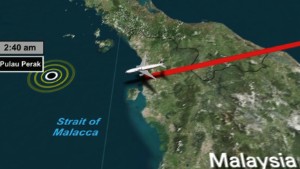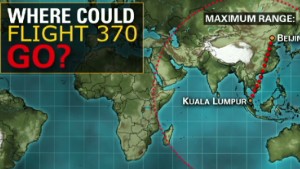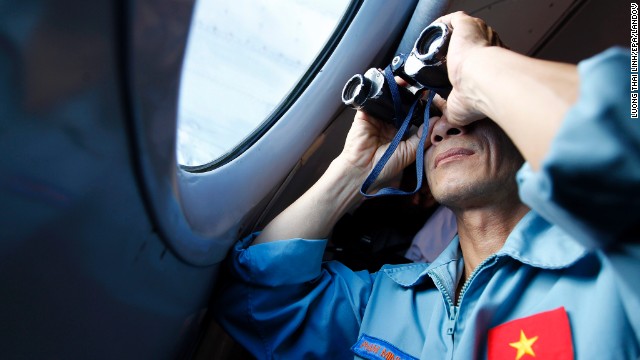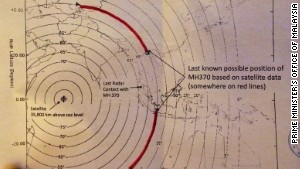Malaysia Flight 370: Amid a sea of questions, 30 of the most compelling
March 15, 2014 -- Updated 1736 GMT (0136 HKT)
STORY HIGHLIGHTS
- Inmarsat joins the investigation team
- Authorities don't know where it is or what happened to it
- Many conspiracy theories have emerged in the absence of hard data on the plane
- Beijing-bound aircraft disappeared a week ago with 239 passengers, crew aboard
(CNN) -- Questions about the fate of Malaysia Airlines Flight 370, which disappeared a week ago over Southeast Asia, continued Friday to hang in the air. Here is what we know -- and don't know -- from hard data to conspiracy theories.
Malaysian authorities said the plane's last communication was in one of two possible corridors. 1: from northern Thailand to the border of Kazakhstan and Turkmenistan 2: from Indonesia to southern Indian Ocean.
THE SEARCH
1. Just where could the plane be?
As evidence grows that the plane could have flown for hours after losing contact with air traffic control, the search area, too, has grown.
Malaysia's aviation authorities -- with concurrence from U.S. and British government experts -- concluded that the plane's last communication with the satellite was in one of two possible corridors -- "a northern corridor stretching from the border of Kazakhstan and Turkmenistan to northern Thailand or southern corridor from Indonesia to southern Indian Ocean," Prime Minister Najib Razak told reporters Saturday.
The latest data and calculations provided by Malaysian officials show an arc of places the aircraft could have traveled.
Because the northern reaches of the arc include some tightly guarded airspace over India, Pakistan and U.S. installations in Afghanistan, U.S. authorities believe it more likely the aircraft crashed south of India into waters outside of the reach of radar, one U.S. official said. That's because, had it flown farther north, it would likely have been detected by radar, the official said.
And a classified analysis of electronic and satellite data suggests Malaysia Airlines Flight 370 likely crashed either in the Bay of Bengal or elsewhere in the Indian Ocean, CNN learned Friday.
The analysis, conducted by the United States and Malaysian governments, used radar data and satellite pings to calculate that the plane diverted to the west, across the Malayan peninsula, and then either flew in a northwest direction toward the Bay of Bengal or southwest into another part of the Indian Ocean.
2. What happened to the plane?
Malaysian military radar registered dramatic changes for Flight 370 in altitude -- going up to 45,000 feet, before descending to 23,000 feet -- and cut an erratic path as it flew across Malaysia in what are some of the last known readings of the plane's location, according to a senior US official.
The same official, who is familiar with analysis of the data and declined to be identified because of the sensitive nature of the information, cautioned that this assessment is not definitive. The readings may not be wholly reliable due to the distance the plane was operating from the radars that detected it, the official said.
3. Did the aircraft go off course?
Yes, according to Najib.
Military radar data showed that Flight 370 deviated from its flight path -- Kuala Lumpur to Beijing -- turning westward back over peninsular Malaysia before turning northwest, he said.
At that point, it left radar coverage.
A big problem is that the plane's identifying transponder stopped working. Though the jet remained visible to radar, that is more difficult to follow.
4. What resources are being devoted to the search?
As of Saturday, 43 ships and 58 aircraft from 14 countries were involved in the search. And experts from the United States, Britain and China are involved.
Two Chinese warships headed Saturday to the Strait of Malacca to continue their search, the Chinese state news agency Xinhua reported.
5. If the plane crashed into the water, would anything still be floating?
Not large pieces of the plane, according to Steve Wallace, the U.S. Federal Aviation Administration's former director of accident investigation. But "it's certainly possible that substantial pieces of lightweight debris, not aircraft structure, could be found floating six days after the aircraft struck the water," he said. That could include things like life jackets and seat cushions, he said.
A FAILURE TO COMMUNICATE
6. How does a plane the size of a Boeing 777-200ER just disappear?
It doesn't. The plane is about 200 feet wide, 200 feet long and six stories tall. It -- or its pieces -- are somewhere. It doesn't help that Flight 370's flight path is unclear and that the search areas include vast waters and sparsely populated jungles and mountains.
But its apparent disappearance is made even stranger by the fact that the jet was laden with massive amounts of technology, including a transponder, UHF and VHF radios, automatic beacons, GPS and computer communications systems, as well as the cell phones of the passengers and crew.
7. What role does the transponder play, and why do I hear so much about it?



A transponder is a radio transmitter that is in the cockpitand works with ground radar to communicate with air traffic controllers. When it receives a radar signal, it returns a code that identifies the aircraft, its speed, the altitude and the position. It's a key element because it stopped working during the flight.
8. Do we know why it stopped working? How do you turn it off?
That's a key question. The transponder is between the pilots and can be turned off with a twist of the wrist, but former airline Capt. Mark Weiss said that, because of the vital information it provides, it's highly unlikely a pilot would turn it off. Though it is considered reliable, it sometimes fails, which is why the jet carries a backup transponder.
But activating the second transponder would have required that the pilot or co-pilot make the switch, something he may find difficult to do in a high-stress situation. Without the cockpit voice recorder and flight data recorder, it's difficult to say who was in the cockpit and what happened, Weiss said.
That may be intentional. One reason to turn off the transponder would be to hide the plane's flight information from radar screens.
Other experts give conflicting opinions: One says the circumstances point to someone -- perhaps a hijacker -- deliberately turning the plane around; another says a catastrophic power failure could explain the anomalies.
9. What about the plane's data and voice recorders?
Investigators would love to find the recorders, which -- assuming they were not destroyed in a crash -- would hold a trove of information on what was going on in the cockpit at the time the plane disappeared from radar, as well as technical data about what the plane was doing and how it was performing. The problem is that investigators have not been able to detect where they might be. So, until searchers can narrow their efforts, they won't help.
And time could prove key: The recorders' batteries die after about 30 days.
10. Was anything else on the plane sending data?
Authorities believe that "pings" from the plane's Aircraft Communications Addressing and Reporting System (ACARS) were transmitted to satellites for four to five hours after the transponder stopped sending signals, a senior U.S. official told CNN.
That information, combined with radar data and the fuel the jet was known to be carrying, suggests that the plane may have flown to the Indian Ocean, the official said. That would be in the opposite direction of the plane's scheduled route from Kuala Lumpur to Beijing.


But the reports on this latest lead have conflicted: Malaysian authorities had said earlier that nothing on the plane was transmitting after 1:07 a.m. last Saturday.
A week after the plane went missing, Prime Minister Najib said Saturday that, "based on new satellite communication, we can say with a high degree of certainty that ... ACARS was disabled just before the aircraft reached the east coast of peninsular Malaysia."
11. What is ACARS?
Introduced in 1978, the air/ground data system was initially used by airlines to record and report basic aircraft movement messages, according to Rockwell Collins, which sells avionics and communications systems to aviation customers. In 1989, ACARS's use was expanded to include air traffic service communications. It uses three radio frequency paths for delivery: two ground-based satellite systems (VHF and UHF) and a satellite link (SATCOM) to send and receive information.
"It's a system where you send digital communications from ship to ground," said John Testrake, a pilot for American Airlines with more than 20 years' experience flying. The automated system generally sends routine messages to the airline, like when the aircraft lifted off or landed and how much fuel it may have, he said. It can also be used to communicate text messages like "light continuous turbulence over the Rockies south of Denver," he said.
"You might want to send that report to your dispatcher so they can give a heads up to the next flight that's coming into that area."
Tom Haueter, former director of the National Transportation Safety Board's Office of Aviation Safety, said ACARS typically beams down engine parameters, temperatures, the amount of fuel burn and any maintenance discrepancies.
According to Malaysia Airlines, all of its aircraft are equipped with ACARS, which transmits data automatically. "Nevertheless, there were no distress calls, and no information was relayed," the airline said.
12. How long was this system working?
The aircraft's ACARS was sending pings over five hours after the transponder last emitted a signal, an aviation industry source told CNN on Friday. These pings don't provide information about speed or altitude, but they do indicate the plane was intact for that long since an aircraft has to be powered and have structural integrity for the ACARS to operate, the source said.
The pings were detected by satellites, which -- combined with radar and other data -- was used to calculate where the plane may have traveled. A U.S. official, who spoke to reporters on condition of anonymity, said the satellite recorded electronic "handshakes" with the 777 that were later analyzed.
The information gleaned from this analysis -- which the U.S. official described as "unprecedented" -- fueled the conclusion that the aircraft turned toward the west -- away from the Gulf of Thailand and toward the Indian Ocean. Referring to the five-to-six hour range in which the plane may have flown after its transponder cut off, the same official said, "We believe we have the time of the loss of the airplane within an hour."
13. And what about Inmarsat?
On Friday, Inmarsat said its network had registered routine, automated signals from Flight 370, and that the information had been provided to Malaysia Airlines. It did not specify which of its voice and data services may have been involved.
On Saturday, the provider of global mobile satellite communications services said it had been appointed as a technical adviser to the U.K. Air Accident Investigation Branch on the flight.
A company spokesman said because Inmarsat is advising the branch's technical committee, he was unable to discuss the data.
THE PILOTS, THE COCKPIT AND THE BATHROOM
14. Just how experienced were the pilots?
Very. Fariq Ab Hamid, 27, who joined Malaysia Airlines in 2007, was first officer on the flight. He has 2,763 flying hours and was transitioning to the Boeing 777-200 after finishing training in a flight simulator. The pilot, Capt. Zaharie Ahmad Shah, 53, has 18,365 flying hours. He joined the airline in 1981.
15. If they're so experienced, why did I read about the first officer letting passengers in the cockpit on another flight? Is that legal?
Jonti Roos has said that Fariq invited her and a friend into the cockpitfor a 2011 flight from Phuket, Thailand, to Kuala Lumpur, Malaysia, from takeoff to touchdown. Though this would be a violation of U.S. regulations put in place after the September 11, 2001, attacks, the legality would vary from country to country. Upon learning of Roos' assertion, Malaysia Airlines said it was "shocked," and former FAA Chief of Staff Michael Goldfarb said such behavior "violates every code of conduct."
Though what Fariq is accused of having done would have been against company policy, "nobody on that plane is going to stop him," Testrake said. Still, such behavior would have resulted in firing on a U.S. carrier, he said. "The days are long gone where you could invite the pretty girl up; there are other ways to get pretty girls."
16. They're experienced, but that doesn't mean they couldn't have made a mistake, does it?
Certainly possible. That's what the investigation showed happened with the 2009 Air France flight, though there was an element of mechanical failure as well. In that case, though, there was also inclement weather -- not the case with Flight 370.
17. Was the cockpit door locked?
We don't know what was going on in the Boeing jet, but, since the September terrorist attacks, "the door is always locked any time a plane is moving," said American's Testrake.
And when nature calls?
The pilot would not discuss specifics but noted, "Basically, it involves other crew members, so there's always at least two members in the cockpit. The door is unlocked briefly, for a few seconds, just long enough for the people to go in and out."
18. What do we know about the pilots?
Zaharie Ahmad Shah is married and has three children, the youngest of whom is a daughter in her 20s who lives with her parents; they have one grandchild.
Malaysia police searched his home outside Kuala Lumpur on Saturday, a source close to the investigation told CNN.
Fariq Abdul Hamid lives with his parents and some of his four siblings, according to a neighbor.
What appeared to be police dressed in plainclothes entered Hamid's home on Saturday and left carrying bags.
FROM HARD NEWS TO IDLE SPECULATION
19. Didn't The Wall Street Journal report that the plane had sent out engine data for hours?
Yes. The newspaper then corrected its story, saying that data leading investigators to believe the plane had flown for up to five hours actually came from the plane's satellite-communication link. Malaysian officials denied the newspaper's initial report, and a senior aviation source with extensive knowledge of the matter told CNN's Richard Quest that the newspaper's account was wrong. The source told Quest the plane was not sending engine data, as the newspaper had originally reported.
20. Could the plane have landed somewhere?
One theory U.S. officials are considering, according to that Wall Street Journal report, is that someone might have taken the plane to be used for some other purpose later. So it's theoretically possible that the plane could have landed at a remote airstrip where it's being hidden.
But there are some big holes in that theory. The 777 is a big plane. It requires, at minimum, nearly a mile to land. And, says Quest, there's the matter of getting it someplace without setting off alarm bells. "You can't just fly a Triple 7 and not have a radar trace," he said. One senior U.S. official, citing information Malaysia has shared with the United States, told CNN that "there is probably a significant likelihood" that the aircraft is on the floor of the Indian Ocean.
21. Couldn't a pilot just "fly under the radar"?
Again, theoretically. As a tool intended to keep track of what's going on in the sky, radar data don't extend all the way to the ground. Military pilots are trained to take advantage of this when they need to sneak into a country undetected. But those aircraft are also equipped with terrain-evading radar and other features intended to help fighter and helicopter pilots hug the ground, noted aviation consultant Keith Wolzinger of the Spectrum Group. Understandably, Boeing doesn't offer those features on its commercial airliners. "Airline pilots are not trained for radar avoidance," said Wolzinger, himself a former 777 pilot. "We like to be on radar." Also, unlike military craft, civilian airliners don't have gear to detect when they've been spotted on radar. So any efforts to fly undetected would be rudimentary.
22. What about those Chinese satellite photos?
On Wednesday, China released satellite images from a spot in the South China Sea that appeared to show large objects floating in the water Sunday, a day after the disappearance. Search crews checked the location and found no trace of wreckage. China later said that releasing the photos was a mistake and that the images weren't related to the plane, according to a Malaysian official.
23. How about "crowdsourcing"? Could that help find the plane?
Ostensibly. Colorado firm DigitalGlobe has one of the most advanced commercial satellite networks, and its images of the Strait of Malacca and Gulf of Thailand can capture details as small as a baseball field's home plate, the longest side of which is 17 inches. Volunteers can flag anything they find interesting, but so many answered the call this week that the firm's website crashed. (The website appeared to be up on Friday.) Also, there's the vast size of the search area.
24. It's been more than a decade since 9/11, but is foul play possible? Hijackers? Terrorism?
The CIA and FBI aren't ruling it out, but authorities aren't ruling out much, at this point. It's highly suspicious that the plane may have turned around. Those suspicions are further fueled by the loss of communications with the plane, considering the aircraft had "redundant electrical systems" that would have had to be disabled. Robert Francis, former vice chairman of the U.S. National Transportation Safety Board, said his first thought upon hearing the circumstances of the flight's mysterious disappearance was that it blew up, but even an explosion would not be proof of terrorism.
25. What about those passengers who were flying with stolen passports?
Interpol says it has identified the men as Iranians Pouri Nourmohammadi, 18, and Delavar Seyed Mohammad Reza, 29, and Malaysian investigators say neither of them has any apparent connection to terrorist organizations. Stolen passports don't necessarily indicate terrorism. In fact, passengers flew without having their travel documents checked against its lost-and-stolen passport database more than a billion times in 2013, according to Interpol. Among the reasons someone might use a stolen passport: to immigrate to another country, to export goods without being paying taxes or to smuggle stolen goods, people, drugs or weapons.
26. Could mechanical failure explain it?
It's one of the possibilities, but less so since the Prime Minister on Saturday said the plane's movements "are consistent with deliberate action by someone on the plane."
The absence of a debris field could suggest that the pilot may have made an emergency landing on water and the plane then sank intact, but there is still the mystery of the distress signal. There wasn't one. However, aviation consultant Kit Darby has said that it's possible there was a power failure, and during the hour when he had backup power, the pilot was attempting to return to "the airports and a region he knows." There's also the possibility that the tail or a wing tore from the fuselage. This particular Boeing had suffered a clipped wingtip in the past, but Boeing repaired it. Another possibility is that a window or door failed, which would cause the temperature inside the plane to drop to 60 degrees below zero, creating a freezing fog and giving crew members only seconds to don oxygen masks before becoming disoriented and then incapacitated.
27. Could lithium batteries be to blame?
Maybe. Investigators are looking into the possibility that lithium batteries -- which have been blamed in previous crashes -- may have played a role in the disappearance, according to U.S. officials briefed on intelligence and law-enforcement developments in the investigation. The officials spoke on condition of anonymity because they were not authorized to speak to the media.
If the batteries being carried in the cargo hold caused a fire, it could have caused the 777 to crash. But that would not explain other anomalies, like why the plane appears to have turned westward.
A pilot's likely first instinct if lithium batteries were smoldering would have been to turn around and return to the airport of origin -- not to fly for an additional five hours, said Arthur Rosenberg, an aviation expert who is a pilot, engineer and partner in the New York-based law firm Soberman & Rosenberg.
28. Could it have been hit by a meteor?
There was a meteor in the area at takeoff, but this seems to be atop a list of strange conspiracy theories popping up in the absence of empirical data explaining the plane's disappearance. Given what little is known about the flight path, it seems like a long, long shot that a meteor is to blame.
29. What about reports that passengers' cell phones continued operating after the flight's disappearance?
The answer to the question about meteors and conspiracy theories applies here, too. When phones are disabled or turned off -- which would presumably happen after a plane crash -- calls to those cell phones go directly to voice mail. Friends and loved ones of the missing passengers, however, reported ringing when they called. Technology industry analyst Jeff Kagan says a call would connect first to a network before trying to find the end user, and the ringing sound callers hear masks the silence they would otherwise hear while waiting for the connection to be made. "If it doesn't find the phone after a few minutes, after a few rings, then typically, it disconnects, and that's what's happening," he said.
PRECEDENT
30. Is this the first time a plane has vanished?
No. Perhaps no disappearance proved as vexing as Air France 447, which went down after departing Rio de Janeiro on June 1, 2009. It took four searches and almost two years before the bulk of the wreckage and majority of bodies were recovered. The voice and data recorders weren't found on the ocean floor until May 2011.


No comments:
Post a Comment